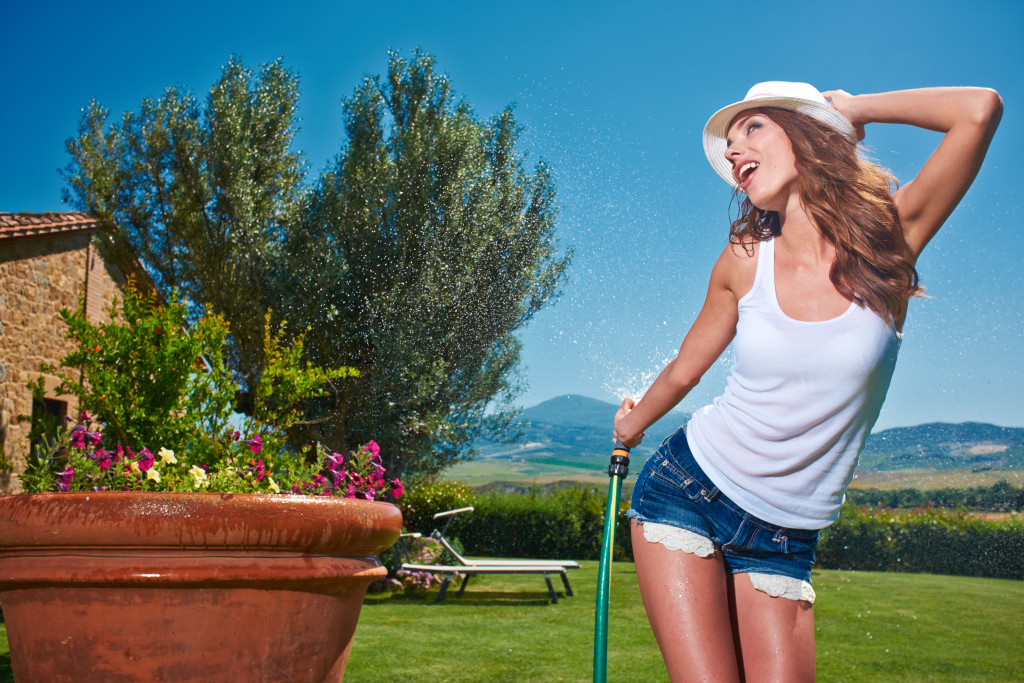LAWNS – ‘I’M SORRY YOU’RE OUT!’
Let’s face it, outside is getting hotter, and not in a good way. We are in the midst of a record drought and our gardens are suffering. This is my reality, it is a painful reality for a passionate gardener. Sigh.
Lawn replacement is getting some well-deserved buzz and I’m an advocate myself. Old water hungry turf grasses and plants from the east are being replaced with drought tolerant native grasses, shrubs, sedges and fescues. But, unlike fashion where trends bounce back and forth and pink is the new black, the garden as a fashion statement or statement of affluence is giving way to the reality that water is short in supply and water hungry landscapes are just not sustainable. A drought tolerant garden is more like the little black dress. It’s here to stay.
But before you start ripping out your old lawn to make room for your new drought tolerant garden you should know that all plants need water. Even succulents and natives need regular water. Especially during their first year or two as they get established. So, planting a new garden before fall during a drought is a bad idea if your goal is to save water and have a garden that thrives.
We need to save water, of course, but another thing we shouldn’t do is let our gardens die. The only thing worse is rolling out the fake stuff. Plastic grass, ‘artificial turf’ to its market friendly name, is not ‘green’ or ecological. The fake stuff is a petrochemical product, creates a heat island and doesn’t do what real grass does, produce oxygen, filter rainwater or cool the air.
We need to remember that our gardens have a function. Evaporation from plant leaves has a cooling effect, they generate oxygen and clean water. And now, with climate change threatening the planet, it is gardens that will suck carbon out of the air and sequester it in living plants if given half a chance. It’s also gardens that provide habitat for birds and bees that produce services essential to us. Despite our water woes, gardens are not optional.
So, here’s some strategies for how you can save water and survive the drought with the garden you have:
Hold more water by adding mulch. Mulch can slow evaporation of water from plants’ root zones. Use organic mulches, such as compost or bark. Never mulch against tree trunks, and spread not more than two or three inches thick. Better yet, let fallen leaves stay in your garden. They provide nutrients and moisture to the plants.
Have a turf grass lawn? Let the grass grow. If you must mow, set your lawnmower to the highest setting to allow the grass to develop a deep root to help your lawn use water better. Leaving the grass clippings on the lawn helps recycle the plant nutrients back into the soil and retain moisture.
If you can’t feel moisture, irrigate — but do so efficiently. Don’t just sprinkle plants. Provide a soaking, enough to penetrate down and around the roots. One do-it-yourself method is to punch four or five small holes into the bottom of one-gallon plastic beverage jugs and fill them with water. Set one to five around each plant, depending on its size.
Timing is also important. Water plants in the early morning or early evening, when temperatures are lower and winds are lighter, to minimize evaporation.
Save water by collecting it from other sources and directing it to the garden. Some sources of secondhand household water are air conditioners, dehumidifiers and fish tanks. Gray water, such as bath, dish and cooking water, can also be used in the garden. Put it on the soil, not on the plants leaves and don’t use water that contains bleach, detergent or fabric softener.
Weed regularly. Weeds use moisture that could be available to the plants you want. But, leave the weeds if you have large expanses with no plants. It’s important to have vegetative cover or mulch on bald areas.
Stop using leaf blowers! You’d never know it, but gasoline-driven leaf blowers have been banned in scores of California counties, including Los Angeles and hundreds of municipalities across the U.S. and Canada because they pollute at greater levels then a car. Consider that wind blows from the nozzles of these machines at speeds in the range of 180 mph. Winds of that force do not occur naturally on Earth, except inside hurricanes and tornadoes. Worse, still, because the wind is carrying away large quantities of heat from the hyperactive engine, it is also very hot and exceedingly dry. Subjecting everything at ground level to blasts of hot, dry, hurricane-force winds would be ill-advised at any time, since it cannot fail to injure plants and open pathways for pests and disease, while at the same time aiding and abetting the pathogens by distributing them over the widest possible area. In the summer, though, when the air is hot and the ground is dry and the plants are dehydrated and badly stressed to begin with, subjecting them to tornadic blasts of hot, dry air is, nonsensical, to put it kindly.
Once summer is over we can have a serious look at planting a more drought tolerant garden.
About the author: Diana Zogran is an ecological gardener, horticulturist, garden coach and environmental health advocate. She engages local residents in building healthy habitats for wildlife and human life. She is committed to redefining the way we think about our gardens and their role in our health, our communities and our planet. She writes about her vision and her work at www.ittakesagarden.com.
Image / Shutterstock

